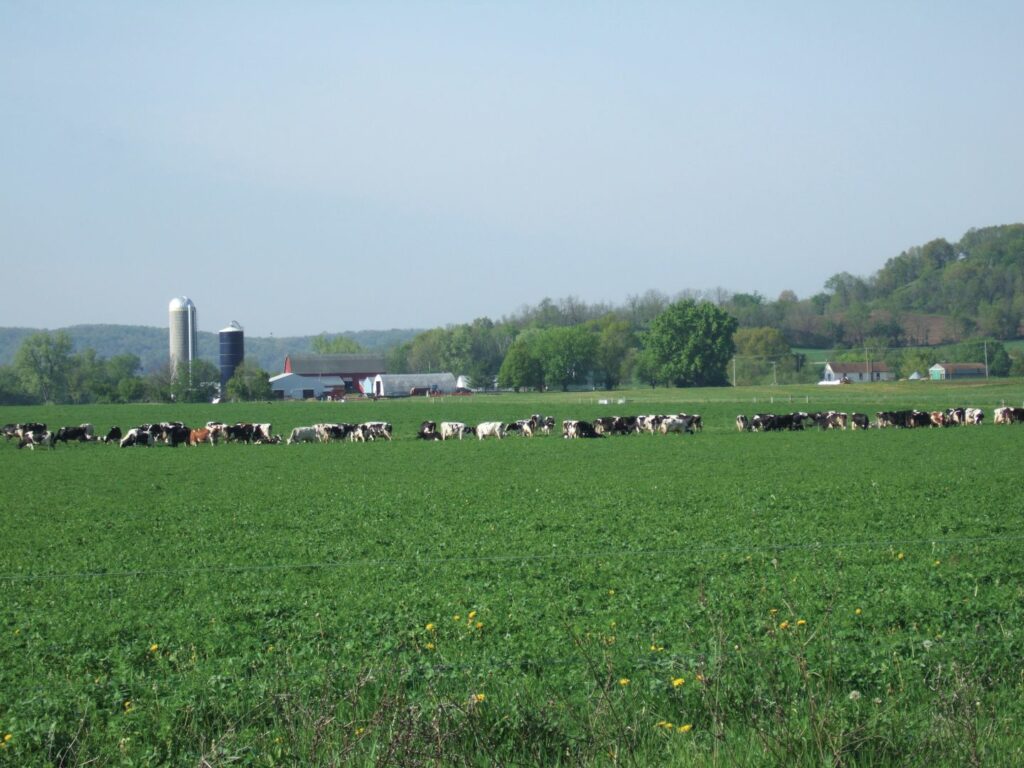Dear Farmer/Agribusiness person,
Field Day is coming up soon; the third Tuesday in August this year is the 19th. Also this year we are back to doing a one day, all day event. Field Day is a celebration of biological agriculture and also a time to show you our farm and farming practices. Otter Creek Organic Farm, my family’s farm, has been in operation since the early 90’s or about 20 years ago. When the farm first started (it was a dairy farm), we began experimenting with a number of trial plots. One was corn on corn which was interseeded with a clover-rye-radish mix. One-third of the field received manure, one-third received extra nitrogen, and the last one-third received just a biological starter fertilizer. I was trying to demonstrate that with manure, starter fertilizer, and cover crops, the need for nitrogen would be minimized. This was 20 years ago, we weren’t organic then, and our yields were 135-150 bushels of corn per acre. Applying minimal herbicides, no insecticides, and using minimal tillage, it was, for the time, very successful. Another trial we tried was to take soil tests and add whatever was missing by doing the numbers calculations, and we learned a great deal from that. One other demonstration plot was a corn bean rotation with different calcium additions from different sources: high calcium lime, gypsum, and Bio-Cal®. This trial we continued for eight years, and learned more every year. For alfalfa, we tried tight rotations, adding grasses to the mix, varying fertilizers, and again we learned a lot. We came up with ideas and developed plans for growing super quality forages with balanced fertility, fast turn over, great quality and excellent yields. It helped set in place our biological fertilizer balances and programs.
With balanced fertility and healthy soils, there was no need for insecticides. I have never seen an economic loss from insect damage in those 20 years.Since that time, my children have gotten involved in the farm and we expanded it. We moved to organic farming, which means we had to switch a few inputs like fertilizers and give up some tools, like the minimal amounts of herbicides we were then using, and the occasional antibiotics for the cows were gone. Paper work and management increased —intensive management is required if you want to be successful but there are financial rewards for making those changes. Today we farm about 1000 acres, milk about 200 cows, and do some cash cropping as well. Ours is a biological/organic farm which means we do everything we can to get the soils healthy and mineralized creating an ideal home for soil life, feeding them, balancing their diet with types of feed and minerals as carefully as we feed our cows. With all the cost increases that have been pushed onto us farmers (land, equipment, fertilizers, chemicals, technology, labor), we feel it’s necessary to raise the bar on inputs and outputs. That means getting more from every acre by using tools such as cover crops, tight rotations, compost, manures, soil correctives, increased crop fertilizers and controlled tillage.
On our good land, under normal growing conditions (whatever that is!), we expect 25-30 tons corn silage, 8 tons hay, 175-200 bushel corn, 60 bushel beans.
There are many ways to farm, but soil health and minerals are common to all. The question is how do we measure soil health and what is it that we measure? How do we measure our progress and what can we expect? You have choices– sustainable, low input, high tech plant altered chemical farming, or a biological, doing the maximum for soil health and crop performance. We do have the knowledge and tools to be successful, using whatever method fits your farm and management style.
What can you expect to see and learn at our Field Day?
Alfalfa: high seeding rate, extra crop fertilizers, foliars and plant feeding.
Corn: from wide row to narrow; both liquids and dry crop fertilizers. Silage corns and grains along with sweet corn. Check out our new cultivator which I believe will make organic row crops easier to grow and more successful with better weed control.
Cover crop plot: all the latest types of plants to give the results needed when and where, with crops to be grown.
Vegetable production: buses will transport visitors to see a nearby vegetable farming operation on several acres, and gearing up to do a large scale local organic farm business with automation and scale in mind.
Dairy: The Otter Creek dairy herd, how we feed and manage on a high forage diet, from calves to heifers to dry cows to the milking herd. Our consultants and livestock nutrition specialists will be there to answer your questions, along with Gary Zimmer’s daughter Sadie, who has taken over herd management. She can give you all the practical daily things we do for healthy, productive cows.
Nutrient management: How nutrients are managed on the farm; use of compost and manure; fertilizer and soil corrective uses.
Farm Stats: Cost of our program and yield expected and experienced.
I hope to see you on Tuesday, Aug. 19.
Gary F. Zimmer

